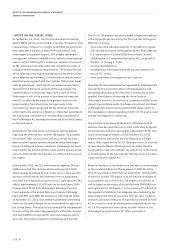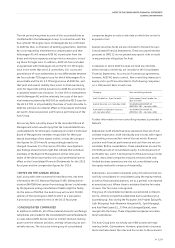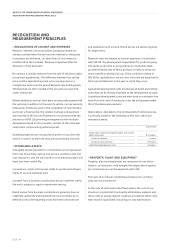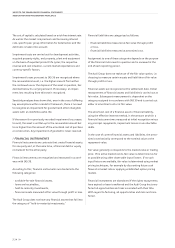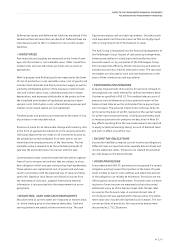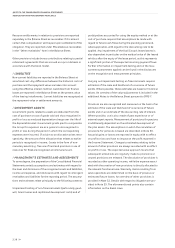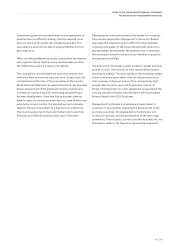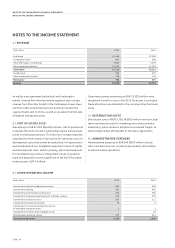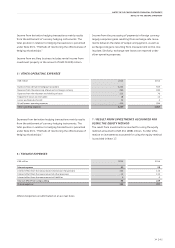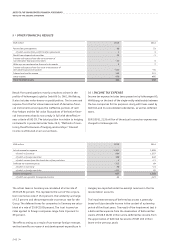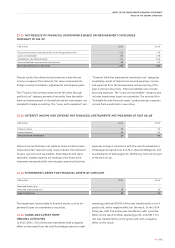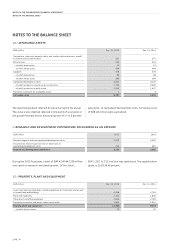Audi 2015 Annual Report Download - page 238
Download and view the complete annual report
Please find page 238 of the 2015 Audi annual report below. You can navigate through the pages in the report by either clicking on the pages listed below, or by using the keyword search tool below to find specific information within the annual report.
NOTES TO THE CONSOLIDATED FINANCIAL STATEMENTS
RECOGNITION AND MEASUREMENT PRINCIPLES
238 >>
Recourse entitlements in relation to provisions are reported
separately in the Balance Sheet as receivables if it is almost
certain that compensation will be paid upon settlement of the
obligation. They are reported under Miscellaneous receivables
in the “Other receivables” item in the Balance Sheet.
Other provisions include bonus contributions relating to partial
retirement agreements that are accrued on a pro rata basis in
accordance with the block model.
/LIABILITIES
Non-current liabilities are reported in the Balance Sheet at
amortized cost. Any differences between the historical costs of
purchase and the repayment value are taken into account
using the effective interest method. Liabilities from finance
leases are reported in the Balance Sheet at the present value
of the leasing installments. Current liabilities are recognized at
the repayment value or settlement amounts.
/GOVERNMENT GRANTS
Government grants related to assets are deducted from the
cost of purchase or cost of goods sold and thus recognized in
profit or loss as a reduced depreciation charge over the life of
the depreciable asset. Government grants paid to compensate
the Group for expenses are as a general rule recognized in
profit or loss during the period in which the corresponding
expenses were incurred. If a claim to an allocation arises retro-
spectively, the amount of the allocation that relates to earlier
periods is recognized in income. Grants in the form of non-
monetary assets (e.g. free use of land and premises or use of
resources for free) are recognized at nominal amount.
/MANAGEMENT’S ESTIMATES AND ASSESSMENTS
To some degree, the preparation of the Consolidated Financial
Statements entails assumptions and estimates with regard to
the level and disclosure of the recognized assets and liabilities,
income and expense, and disclosures with regard to contingent
receivables and liabilities for the reporting period. The assump-
tions and estimates relate principally to the following contents:
Impairment testing of non-financial assets (particularly good-
will, brand names and capitalized development costs) and of
participations accounted for using the equity method or at the
cost of purchase requires that assumptions be made with
regard to future cash flows during the planning period and,
where applicable, with regard to the discounting rate to be
applied. Any impairment of the Audi Group’s leased assets is
also dependent in particular on the residual value of the leased
vehicles after the expiry of the lease period, as this represents
a significant portion of the expected incoming payment flows.
Further information on impairment testing and on the mea-
surement parameters applied can be found in the disclosures
on the recognition and measurement principles.
Carrying out impairment testing on financial assets requires
estimates of the scale and likelihood of occurrence of future
events. Where possible, these estimates are based on historical
values. An overview of the value adjustments is included in the
additional Notes to the Balance Sheet pursuant to IFRS 7.
Provisions are also recognized and measured on the basis of an
estimate of the scale and likelihood of occurrence of future
events and on an estimate of the discounting rate of interest.
Where possible, use is also made of past experience or of
external expert reports. Measurement of provisions for pensions
is additionally dependent on the estimated development of
the plan assets. The assumptions on which the calculation of
provisions for pensions is based are described in Note 30.
Actuarial gains or losses are reported in equity with no effect
on profit or loss and have no impact on the profit reported in
the Income Statement. Changes to estimates relating to the
amount of other provisions are always recorded with an effect
on profit or loss. The expected value approach means that
subsequent allocations are regularly made to provisions or
unused provisions are released. The dissolution of provisions is
recorded as other operating income, while the expense associ-
ated with the creation of new provisions is directly allocated to
the relevant functional area. Warranty claims resulting from
sales operations are determined on the basis of previous or
estimated future losses. An overview of other provisions is
provided in Note 32. Details with regard to litigation are pro-
vided in Note 39. The aforementioned points also contain
information on the diesel issue.


